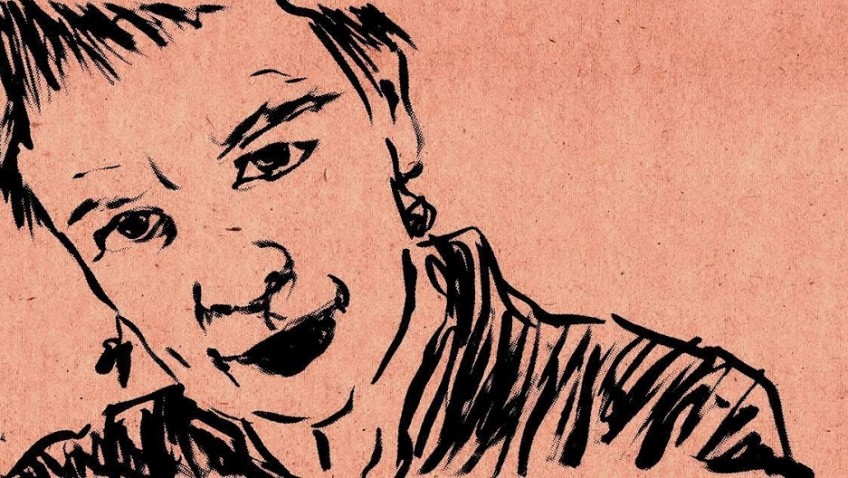Joyce Glasser reviews Heart of a Dog (May 20, 2015)
Performance artist, composer, musician, singer and filmmaker, Laurie Anderson’s first feature film in 29 years does not have a plot; but it has enough humanity, humour, pathos and lyrical beauty to hold you in its meditative trance. Anderson gives us, not a documentary, but a cine-essay in which her rich associative mind is given free rein to explore the relationship between love and death, reality and storytelling. The title is not a reference to Russian revolutionary author Mikhail Bulgahov’s 1925 satire of communism, Heart of a Dog, although both Bulgahov and Anderson do spin their stories around anthropomorphised dogs.
If Bulgahov’s dog is turned into an ego-centric, loathsome new Soviet Man, Anderson’s dog is nothing short of surreal and, appropriately, begins as a dream. Anderson dreams she is in a hospital bed looking not at her newborn baby child, but at the face of her little dog, for whose sake she would move to Northern California. Anderson, and her soul mate and, later, her husband, Lou Reed, were living in Manhattan when 9/11 covered the city in white ash. It was this catastrophe that prompted Anderson to move to the other side of America, and to nature.
The fear of terrorists after 9/11 led to the slogan, ‘If you see something, say something,’ a slogan that has a special resonance with song writers, story tellers and visual artists. This thought leads Anderson to Ludwig Wittgenstein’s, ‘the limits of my language are the limits of my word’. And this might be Anderson’s motive in wishing to teach Lolabelle her language.
‘I wanted to see if I could learn to talk to her’, Anderson says in a deadpan narrative voice-over, referring to her rat terrier, Lolabelle. We will never know how Lolabelle got on with her 500 word vocabulary because, ‘beauty got in the way of the experiment,’ Anderson confesses, referring to the rugged landscape. The beauty was not without danger to a small dog, and we learn that a hawk’s swooping gestures caused little Lolabelle to look over her shoulder, ill at ease. As humans were doing in Manhattan and all over America.
Just as a mother would want to communicate with her ‘child’, so an avant-garde musician mother like Anderson would want her to take piano lessons. Yes, there is an amusing scene of Lolabelle at the keyboard, the black and white dog’s paw tickling the black and white ivory keys.
After the piano scenes, Anderson states: When Lolabelle got older, she went blind. The only place she would run was the edge of the sea’. Again, we adjust our world to feel safe. A discourse about the limited scope of a dog’s vision – their blurred vision and limited colour palette gets mixed in with their sense of smell – leads to fuzzy footage of drones and an aerial view of a huge data storage facility in Utah. All those stories – and all that potential for them to become mixed up with our limited vision! Later in the film Anderson tells us how she adjusted a childhood memory and in the process distorted the truth. So can any story telling be truthful, or is truth necessarily confined to the limits of our world.
Although blind, Lolabelle’s hearing was excellent and the dog was a companion in the recording studio, even recording her own Christmas song, ‘which was good’ Anderson adds, unenthusiastically.
‘Hearing is the last sense to go’… we later learn about the sense that more than anything defines Anderson.
After recounting Lolabelle’s death at home, Anderson tells us that crying is prohibited in the Tibetan Book of the Dead because it confuses the dead. ‘Instead of crying, give something away’, she suggests because crying is more about you than about the dead one. Then, what is perhaps the closest thing to a message in the film: ‘The purpose of death is the release of love.’
Anderson then tells us how much love she has had to release. ‘I’ve seen three ghost now and the first was Gordon’ she tells us referring to the early death of her close friend, the talented conceptual sculptor Gordon Matta-Clark (1943-1978) whose twin brother had committed suicide from the roof of Gordon’s studio. Gordon spent the last 24 hours of his life reading to his friends….Again, ‘hearing is the last sense to go…’
She then quotes from another artist who died young, the writer David Foster Wallace, who said ‘Every love story is a ghost story,’ We then hear about the death of Anderson’s mother, and then, movingly, of the death of Lou Reid in 2013, to whom the film is dedicated.
Despite informing us of her cold relationship to her estranged mother, Anderson finds common ground, significant enough to mention. ‘When my mother died, she was talking to the animals on the ceiling.’ The ghost of Lolabelle and the mothering image from the first lines of the film return. ‘For two years after Lolabelle’s death she continued to get notifications on her Face Book page, Anderson mentions again bringing up communication and the distortion of truth. Stories become distorted by our mental filters and by time. Anderson tells us an anecdote about the day when, having taken her brother on the frozen pond, she saved him from drowning and of her mother’s unexpected reaction.
‘Turn, turn around – that is what love is…Turning time around’. Heart of a Dog turns time around as Anderson ends with the death of Lou Reed.
Anderson wrote the voice-over that she recites, drew the artwork that animates certain segments, and, of course, composed and recorded most of the music, allows key words and subconscious thoughts to lead us down seemingly unconnected paths, always revealing the connections. This is a risky structure and other experimental works of this type have been more, rather than less, boring and self-indulgent. Heart of a Dog succeeds due to the lyrical quality of the word and images, as well as their thought-provoking universality.




